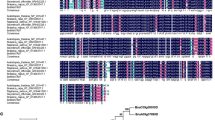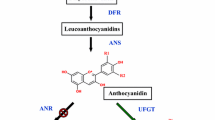Abstract
Methylthioalkylmalate (MAM) synthases and their associated genes that have been extensively investigated in Arabidopsis control the side-chain elongation of methionine during the synthesis of aliphatic glucosinolates. A Brassica homolog of the Arabidopsis MAM genes was used in this study to analyze the role of MAM genes in B. napus through RNA interference (RNAi). The silencing of the MAM gene family in B. napus canola and B. napus rapeseed resulted in the reduction of aliphatic glucosinolates and total glucosinolate content. The results indicated that RNAi has potential for reducing glucosinolate content and improving meal quality in B. napus canola and rapeseed cultivars. Interestingly, MAM gene silencing in B. napus significantly induced the production of 2-propenyl glucosinolate, a 3-carbon side-chain glucosinolate commonly found in B. juncea mustard. Most transgenic plants displayed induction of 2-propenyl glucosinolate; however, the absolute content of this glucosinolate in transgenic B. napus canola was relatively low (less than 1.00 μmol g−1 seed). In the high glucosinolate content progenies derived from the crosses of B. napus rapeseed and transgenic B. napus canola, MAM gene silencing strongly induced the production of 2-propenyl glucosinolate to high levels (up to 4.45 μmol g−1 seed).




Similar content being viewed by others
References
Bednarek P, Pislewska-Bednarek M, Svatos A, Schneider B, Doubsky J, Mansurova M, Humphry M, Consonni C, Panstruga R, Sanchez-Vallet A, Molina A, Schulze-Lefert P (2009) A glucosinolate metabolism pathway in living plant cells mediates broad-spectrum antifungal defense. Science 323:101–106
Beekwilder J, van Leeuwen W, van Dam NM, Bertossi M, Grandi V, Mizzi L, Soloviev M, Szabados L, Molthoff JW, Schipper B, Verbocht H, de Vos RC, Morandini P, Aarts MG, Bovy A (2008) The impact of the absence of aliphatic glucosinolates on insect herbivory in Arabidopsis. PLoS ONE 3:e2068
Benderoth M, Textor S, Windsor AJ, Mitchell-Olds T, Gershenzon J, Kroymann J (2006) Positive selection driving diversification in plant secondary metabolism. Proc Natl Acad Sci USA 103:9118–9123
Celenza JL, Quiel JA, Smolen GA, Merrikh H, Silvestro AR et al (2005) The Arabidopsis ATR1 Myb transcription factor controls indolic glucosinolate homeostasis. Plant Physiol 137:253–262
Chen SX, Glawischnig E, Jorgensen K, Naur P, Jorgensen B, Olsen CE, Hansen CH, Rasmussen H, Pickett JA, Halkier BA (2003) CYP79F1 and CYP79F2 have distinct functions in the biosynthesis of aliphatic glucosinolates in Arabidopsis. Plant J 33:923–937
Clay NK, Adio AM, Denoux C, Jander G, Ausubel FM (2009) Glucosinolate metabolites required for an Arabidopsis innate immune response. Science 323:95–101
de Kraker JW, Luck K, Textor S, Tokuhisa JG, Gershenzon J (2007) Two Arabidopsis genes (IPMS1 and IPMS2) encode isopropylmalate synthase, the branch point step in the biosynthesis of leucine. Plant Physiol 143:970–986
Fahey JW, Zhang Y, Talalay P (1997) Broccoli sprouts: an exceptionally rich source of inducers of enzymes that protect against chemical carcinogens. Proc Natl Acad Sci USA 94:10367–10372
Gigolashvili T, Berger B, Mock HP, Muller C, Weisshaar B et al (2007a) The transcription factor HIG1/MYB51 regulates indolic glucosinolate biosynthesis in Arabidopsis thaliana. Plant J 50:886–901
Gigolashvili T, Yatusevich R, Berger B, Muller C, Flugge UI (2007b) The R2R3-MYB transcription factor HAG1/MYB28 is a regulator of methionine-derived glucosinolate biosynthesis in Arabidopsis thaliana. Plant J 51:247–261
Grubb CD, Abel S (2006) Glucosinolate metabolism and its control. Trends Plant Sci 11:89–100
Halkier BA, Gershenzon J (2006) Biology and biochemistry of glucosinolates. Annu Rev Plant Biol 57:303–333
Hasan M, Friedt W, Pons-Kühnemann J, Freitag NM, Link K, Snowdon RJ (2008) Association of gene-linked SSR markers to seed glucosinolate content in oilseed rape (Brassica napus ssp. napus). Theor Appl Genet 116:1035–1049
Hirai MY, Sugiyama K, Sawada Y, Tohge T, Obayashi T et al (2007) Omics based identification of Arabidopsis Myb transcription factors regulating aliphatic glucosinolate biosynthesis. Proc Natl Acad Sci USA 104:6478–6483
Kliebenstein DJ, Kroymann J, Brown P, Figuth A, Pedersen D, Gershenzon J, Mitchell-Olds T (2001) Genetic control of natural variation in Arabidopsis thaliana glucosinolate accumulation. Plant Physiol 126:811–825
Kraling K, Robbelen G, Thies W, Herrmann M, Ahmadi MR (1990) Variation in seed glucosinolates in lines of Brassica napus. Plant Breed 105:33–39
Kroymann J, Textor S, Tokuhisa JG, Falk KL, Bartram S, Gershenzon J, Mitchell-Olds T (2001) A gene controlling variation in Arabidopsis glucosinolate composition is part of the methionine chain elongation pathway. Plant Physiol 127:1077–1088
Kroymann J, Donnerhacke S, Schnabelrauch D, Mitchell-Olds T (2003) Evolutionary dynamics of an Arabidopsis insect resistance quantitative trait locus. Proc Natl Acad Sci USA 100:14587–14592
Li G, Quiros CF (2002) Genetic analysis, gene expression and molecular characterization of BoGSL-ELONG, a major gene involved in the aliphatic glucosinolate pathway of Brassica species. Genetics 162(4):1937–1943
Li G, Quiros CF (2003) The Brassica oleracea gene BoGSL-ALK regulates in planta alkenyl aliphatic glucosinolates in Arabidopsis thaliana. Theor Appl Genet 106:1116–1121
Li G, Gao M, Yang B, Quiros CF (2003) Gene to gene alignment between the Arabidopsis and Brassica oleracea genomes. Theor Appl Genet 107:168–180
Magrath R, Herron C, Giamoustaris A, Mithen R (1993) The inheritance of aliphatic glucosinolates in Brassica napus. Plant Breed 111:55–72
Magrath R, Bano F, Morgner M, Parkin I, Sharpe A, Lister C, Dean C, Turner J, Lydiate D, Mithen R (1994) Genetics of aliphatic glucosinolates. 1. Side chain elongation in Brassica napus and Arabidopsis thaliana. Heredity 72:290–299
Matthiessen JN, Shackleton MA (2005) Biofumigation: environmental impacts on the biological activity of diverse pure and plant-derived isothiocyanates. Pest Manag Sci 61:1043–1051
McVetty PBE, Fernando D, Li G, Tahir M, Zelmer C (2009) High-erucic acid, low-glucosinolate rapeseed (HEAR) cultivar development in Canada. In: Hou CT, Shaw JF (eds) Biocatalysis and agricultural biotechnology. CRC, Boca Raton, pp 43–61
Moloney MM, Walker JM, Sharma KK (1989) High efficiency transformation of Brassica napus using Agrobacterium vectors. Plant Cell Rep 8:238–242
Nesi N, Delourme R, Brégeon M, Falentin C, Renard M (2008) Genetic and molecular approaches to improve nutritional value of Brassica napus L. seed. C R Biol 331:763–771
Nour-Eldin HH, Hansen BG, Norholm MHH, Jensen JK, Halkier BA (2006) Advancing uracil-excision based cloning towards an ideal technique for cloning PCR fragments. Nucleic Acids Res 34:e122
Quiros CF, Grellet F, Sadowski J, Suzuki T, Li G, Wroblewski T (2001) Arabidopsis and Brassica comparative genomics: sequence, structure and gene content in the ABI1-Rps2-Ck1 chromosomal segment and related regions. Genetics 157:1321–1330
Reintanz B, Lehnen M, Reichelt M, Gershenzon J, Kowalczyk M, Sandberg G, Godde M, Uhl R, Palme K (2001) Bus, a bushy Arabidopsis CYP79F1 knockout mutant with abolished synthesis of short-chain aliphatic glucosinolates. Plant Cell 13:351–367
Schuster J, Knill T, Reichelt M, Gershenzon J, Binder S (2006) BRANCHED-CHAIN AMINOTRANSFERASE4 is part of the chain elongation pathway in the isoynthesis of methionine derived glucosinolates in Arabidopsis. Plant Cell 18:2664–2679
Sønderby IE, Hansen BG, Bjarnholt N, Ticconi C, Halkier BA et al (2007) A systems biology approach Identifies a R2R3 MYB gene subfamily with distinct and overlapping functions in regulation of aliphatic glucosinolates. PloS ONE 2:e1322
Textor S, Bartram S, Kroymann J, Falk KL, Hick A, Pickett JA, Gershenzon J (2004) Biosynthesis of methionine-derived glucosinolates in Arabidopsis thaliana: recombinant expression and characterization of methylthioalkylmalate synthase, the condensing enzyme of the chain-elongation cycle. Planta 218:1026–1035
Textor S, de Kraker JW, Hause B, Gershenzon J, Tokuhisa JG (2007) MAM3 catalyzes the formation of all aliphatic glucosinolate chain lengths in Arabidopsis. Plant Physiol 144:60–71
Vinjamoori V, Byrum JR, Hayes T, Das PK (2004) Challenges and opportunities in the analysis of raffinose oligosaccharides, pentosans. J Anim Sci 82:319–328
Zang YX, Kim JH, Park YD, Kim DH, Hong SB (2008) Metabolic engineering of aliphatic glucosinolates in Chinese cabbage plants expressing Arabidopsis MAM1, CYP79F1, and CYP83A1. BMB Rep 41:472–478
Zang YX, Kim HU, Kim JA, Lim MH, Jin M, Lee SC, Kwon SJ, Lee SI, Hong JK, Park TH, Mun JH, Seol YJ, Hong SB, Park BS (2009) Genome-wide identification of glucosinolate synthesis genes in Brassica rapa. FEBS J 276:3559–3574
Zhang GY, Talalay P, Cho C, Posner GH (1992) A major inducer of anticarcinogenic protective enzymes from broccoli: isolation and elucidation of structure. Proc Natl Acad Sci USA 89:2399–2403
Acknowledgments
The research was supported by the Genome Canada/Genome Alberta and Genome Prairie project “Designing Oilseeds for Tomorrow’s Markets” and Manitoba Provincial Government. We thank Dr. Rakow from Agriculture Agri-Food Canada, Saskatoon who provided the material DH12075 for plant transformation.
Author information
Authors and Affiliations
Corresponding author
Electronic supplementary material
Below is the link to the electronic supplementary material.
Rights and permissions
About this article
Cite this article
Liu, Z., Hammerlindl, J., Keller, W. et al. MAM gene silencing leads to the induction of C3 and reduction of C4 and C5 side-chain aliphatic glucosinolates in Brassica napus. Mol Breeding 27, 467–478 (2011). https://doi.org/10.1007/s11032-010-9444-y
Received:
Accepted:
Published:
Issue Date:
DOI: https://doi.org/10.1007/s11032-010-9444-y




